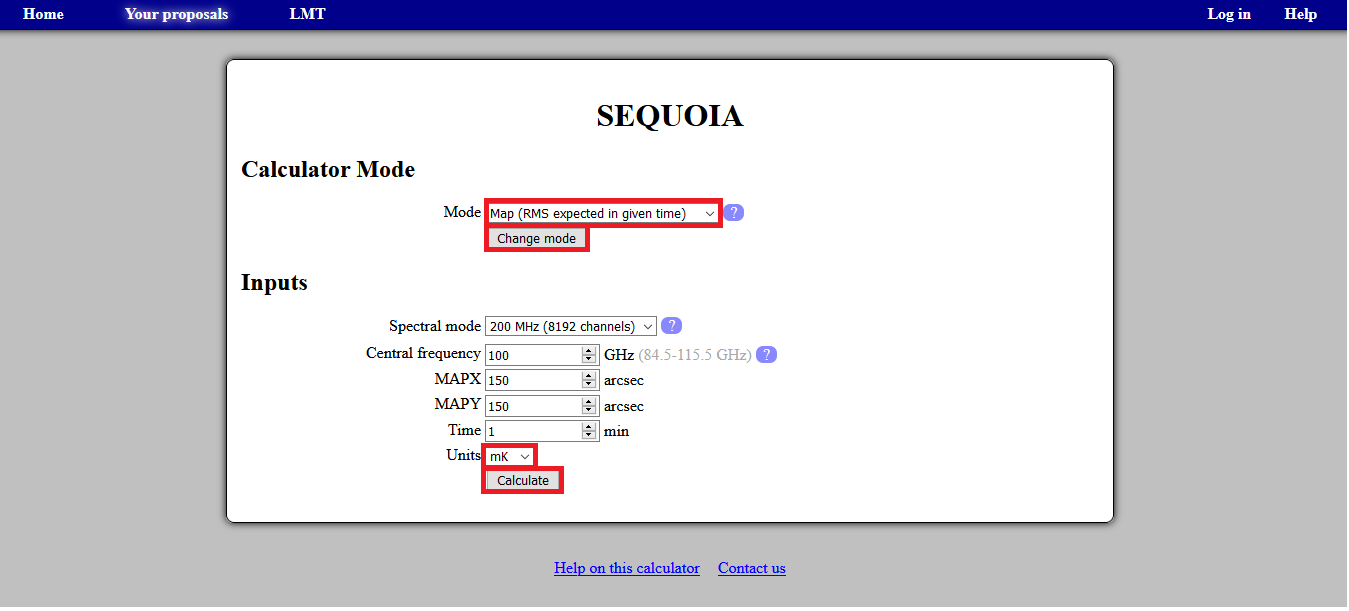SEQUOIA Sensitivity/Integration Time Calculator
This calculator can be used to estimate sensitivity or integration times for the Second Quabbin Optical Imaging Array SEQUOIA on the 50-m LMT.
Receiver
SEQUOIA is a cryogenic focal-plane array of 16 pixels, arranged in a dual-polarized 4×4 array, that operates in the range 85 – 115 GHz. The array, which is feed by square horns separated by 2 f λ, is cooled to 18K and use low-noise Indium Phosphide (InP) monolithic microwave integrated circuit (MMIC) preamplifiers designed at UMass to provide a characteristic receiver noise of 55K in the range 85-107 GHz, increasing to 90K at 115 GHz. SEQUOIA was the workhorse facility instrument for the FCRAO 14-m telescope for many years, and it will remain the largest heterodyne spectral line camera operating 3 mm when it operates on the LMT. The calculator allows estimates using both antenna temperature (TA*) units and flux density [mJy], based on estimated sensitivity of 3.2 Jy/K for the 50m LMT.
Calculation Modes
NOTE: The “Input parameters” section provides a description of each parameter required by the calculators.
The SEQUOIA calculator allows to choose between two different observing modes: 1) Position Switching (PS) Mode for pointed observations and 2) Map Mode designed for mapping extended regions of the sky. As described below, both calculators can be used to estimate the “RMS expected in given time” and the “Time required for target RMS”.
Position Switching (PS) Mode:
- RMS expected in given time: choose the spectral mode and provide your desired integration time in minutes. Press the ‘Calculate’ button to determine the sensitivity in the selected units (mK or mJy).
- Time required for target RMS: choose the spectral mode and provide your desired sensitivity (in order to change units press the ‘Units’ button and select between mK or mJy). Press the ‘Calculate’ button to determine the required integration time.
Map Mode:
Choose the spectral mode. Provide the central frequency in GHz and the size of the desired map in arcsec.
- RMS expected in given time: provide the desired integration time (in minutes) and press the ‘Calculate’ button to determine the sensitivity in the selected units (mK or mJy).
- Time required for target RMS: provide the desired sensitivity (in order to change units press the ‘Units’ button and select between mK or mJy). Press the ‘Calculate’ button to determine the required integration time.

For the Map Mode calculator, the spectral mode, central frequency and map size will define the time required to make a single map and its corresponding depth. The total time or final RMS is estimated in multiples (integer) of single map realizations. If the total time or final RMS required does not correspond to an integer number of maps, the calculator outputs the nearest options (rounded up). For reference, the calculator also outputs the required time to complete one single map and its expected depth.
If a project requires different transition lines to be targeted (and which do not fall within a single band width), integration times must be estimated for each transition and added to estimate the total time to be requested in the proposal.
You can find a description of the instrument and further documentation in the SEQUOIA.
Input parameters
SEQUOIA’s spectrometer can operate in three different spectral modes, which define the spectral band width and number of channels. The user will have to select between these three available Spectral Modes:

Central frequency [GHz] of your expected line, between 84.5 - 115.5 GHz
MAPX [arcsec]: Desired map size in the X direction (must be >=150 arcsec)
MAPY [arcsec]: Desired map size in the Y direction (must be >=150 arcsec)
TIME [min]: where the user gives a desired RMS to be reached and the required time is calculated.
RMS [mK or mJy]: where the user gives a proposed integration time and the corresponding RMS is estimated.